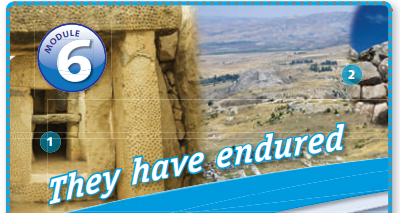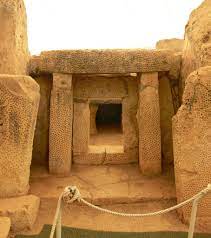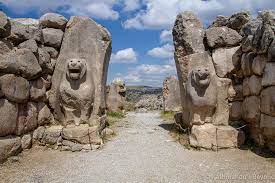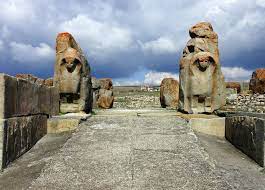Unit 6
They have endured centuries!
centuries!
Before you start If you had to build something to last for centuries, what would it be? Who would it be for? How would you build it?
Look at these picture from your SB page 61
Wha do they show?


The answer: The order of the photos is Mnajdra, Hattusha, Hattusha and Stonehenge.
**********************************
|
Background 1. Stonehenge is one of the most ancient monuments in the world. We do not know who built it or why. We now know that the building of it started around 3100 BCE and it lasted until 1100 BCE. At Stonehenge, you can see a large circular ditch and large standing stones. UNESCO added Stonehenge to its list of World Heritage Sites in 1986. 2. From about 1375 BCE to 1200 BCE, Hattusha, in Turkey, was the capital of the Hittite Empire. This empire incorporated parts of Syria. Several large temple complexes, many fortifi cations and some impressive pictures carved into the rock walls have survived to the present day. 3. The Mnajdra /mnaIdZr´/ Neolithic complex in Malta is one of the most ancient religious sites on Earth. Prehistoric men built it between 3600 and 2000 BCE, so it’s older than the pyramids. Today, we can see part of the ceiling and great stone doorways among the ruins. |
SB page 61/ exercise 1:
1 Following the Listening Strategies, listen to a specialist talking about three places. Match them to the descriptions and the pictures above.
a. It was the capital of an empire more than 3,000 years ago.
b. It took people 2,000 years to build it, and we still do not know why it was built, or who built it.
c. It’s a religious site, older than the pyramids.
The answer:
The order of the photos is Mnajdra, Hattusha, Hattusha and Stonehenge.
a. 2 (picture 2); b. 1 (picture 3); c. 3 (picture 1)
Another photos for these places:
 Manajdra
Manajdra  Hattusha
Hattusha  Hattusha and Stonehenge.
Hattusha and Stonehenge.
*The key words:
| The word / phrase | The meaning | The part of speech |
| prehistoric | relating to or denoting the period before written records. | Adjective |
| complex | onsisting of many different and connected parts | Adjective |
| ditch | a narrow channel dug in the ground, typically used for drainage alongside a road or the edge of a field. | Noun |
| heratige | property that is or may be inherited; an inheritance. | Noun |
| empire | an extensive group of states or countries under a single supreme authority, formerly especially an emperor or empress. | Noun |
| site | an area of ground on which a town, building, or monument is constructed | Noun |
| to carve | cut (a hard material) in order to produce an object, design, or inscription | Verb |
| to incorporate | take in or contain (something) as part of a whole; include. | Verb |
SB page 61 / exercise 2:
2 Listen to the words below in context. Try to guess their meanings
The answer:
We don’t know much about prehistoric people because they had no writing.
2. If you keep seeing old temples, you might be in a historic complex.
3. I fell into a ditch when I was walking in the dark.
4. The Beatles are a big part of Britain’s musical heritage.
5. The Romans had a large empire which covered most of Europe.
6. The police do not know the exact site of the accident but they are looking for it now.
7. I want to carve my name in this piece of wood but I don’t have a knife.
8. The teacher said she wants to incorporate our ideas into the next class project. I hope she uses some of mine.
******************************************************************
SB page 61/ exercise 3:
In a group, make a list of historic places in your city, region or in other countries corresponding to the three categories below. Say what you can fi nd in them. Use the words in the box to help you. Then, tell the class about them.
a. monument b. religious site c. city
Example:
Petra is a historic and archaeological city in Jordan. It is carved in rock. It’s one of the New Seven Wonders of the World. It’s on UNESCO’s list of World Heritage Sites
The answer:Students’ own answers
******************************************************************
Lessons 2 and 3
The lost city of the Incas
While reading:
The lost city of the Incas
For your information:
| Inca, also spelled Inka, South American Indians who, at the time of the Spanish conquest in 1532, ruled an empire that extended along the Pacific coast and Andean highlands from the northern border of modern Ecuador to the Maule River in central Chile. A brief treatment of the Inca follows; for full treatment, see pre-Columbian civilizations: The Inca. |
SB page 62
|
Susan: Noura! Where have you been? Noura: We’ve just got back from our holiday. We went to (1) _____ . Why don’t you come for dinner and we’ll show you our photos. Susan: I’d love to come! (Pause) Noura: … and these are some of the photos. Susan: Mmm. Lovely photos! Where did you take them? Noura: Well, these are from Lima. Have you ever been there? Susan: No, we have never been to Peru. We went to Mexico two years ago, though. What are these (2) _____ ? Noura: This is the famous Machu Picchu: the lost city of the Incans. It’s one of the largest (3) _____ sites and has survived from 1537 until today. Susan: It’s amazing! What was it: a citadel, a religious (4) _____ ? Noura: Some specialists have suggested that Machu Picchu was a religious refuge. Others have said that it was a military (5) _____ or a prison. Susan: I imagine people are worried about how to (6) _____ it . Noura: Defi nitely! UNESCO has put it on its list of World Heritage Sites and it has named it one of the New Seven Wonders of the World. |
*The key words:
| The word/ phrase | The meaning | The part of speech |
| to suggest | put forward for consideration. | Verb |
| military |
relating to or characteristic of soldiers or armed forces. |
Noun |
| fortification |
a defensive wall or other reinforcement built to strengthen a place against attack. |
Noun |
|
citadel |
a fortress, typically on high ground, protecting or dominating a city.(castle)) | Noun |
SB page 62 / exercise 1:
1 Listen and complete
The answer:1. Peru; 2. ruins; 3. historic; 4. site; 5. fortifi cation; 6. preserve
2 Listen to the words below in context. Try to guess their meanings
| citadel / fortification /military /to suggest |
The answer: 1. I want to suggest going to the library this afternoon but I think my friend will want to do something else
. 2. I like to know what soldiers wear so I have collected military clothes from many countries.
3. The fortifi cation was made with many high walls to protect the city from attack.
4. The old citadel was like a castle I once visited on holiday
*********************************************
SB page 62 / exercise 3:
3 Read the dialogue as a whole. Then, answer these questions in pairs.
1. What are the different suggestions about what Machu Picchu was?
2. Why do you think UNESCO has put Machu Picchu on its list of World Heritage Sites and the New Seven Wonders of the World?
3. What do you think people should do to preserve Machu Picchu?
Suggested answers 1. The suggestions were that Machu Picchu was originally either a religious refuge, a military fortifi cation or a prison.
2. Students’ own answers
3. Students’ own answers
*****************************************